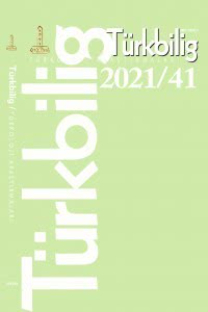Eski Uygur Türkçesinde Niceleyen ve Nicelenen ile Kurulmuş Yapılarda Çokluk Uyumu
Eski Uygur Türkçesi, Türkiye Türkçesi, dinî terminoloji, niceleyen, nicelenen, sıfat tamlaması, çokluk uyumu, çokluk eki
Plurality Agreement in Phrase Structures Formed With the Determiner and the Determined Element in Old Uyghur Turkish
Old Uyghur Turkish, Turkey Turkish, religious terminology, determiners, determined elements, adjective clause, plurality agreement, plurality suffix,
___
- BACANLI, Eyüp (2016). Türk Dillerinde Düzensizlikler. İstanbul: Etkileşim Yayınları.
- BAYRAKTAR, Nesrin (2002). “Asıl sayı sıfatları ve sıfat tamlamalarında çokluk eki uyumsuzluğu”. Lars Johanson Armağanı. Ankara: Grafiker Yayıncılık: 63-71.
- CLAUSON, Gerard (1972). An Etymological Dictionary of Pre-thirteenth Century Turkish. Oxford: Clarendon Press.
- DEMİRCİ, Ü. Özgür (2014). Eski Uygurca Dört Çatik. İstanbul: Kesit Yayınları.
- EDGERTON, Franklin (1953). Buddhist Hybrid Sanskrit, Grammar and Dictionary, Vol. 2: Dictionary. New Haven: Yale University Press.
- ERDAL, Marcel (2004). A Grammar Of Old Turkic. Leiden-Boston: Brill.
- GABAIN, A. Von (2007). Eski Türkçenin Grameri, (Çev. Mehmet Akalın). Ankara: TDK Yayınları.
- GRØNBECH, K., (2011). Türkçenin Yapısı, (çev. Mehmet AKALIN). Ankara: TDK Yayınları.
- GULCALI, Zemire (2013). Eski Uygurca Altun Yaruk Sudur’dan “Aç Bars” Hikâyesi. Ankara: TDK Yayınları.
- HAMILTON, J. Russell (2011). İyi ve Kötü Prens Öyküsü, (Çev. Vedat Köken). Ankara: TDK Yayınları.
- LI, Dejin & CHENG, Meizhen (2008). Practical Chinese Grammar for Foreigners. Beijing: Beijing Language and Culture University Press.
- ÖLMEZ, Mehmet (1991). Altun Yaruk III. Kitap (5. Bölüm). Ankara: Türk Dilleri Araştırmaları Dizisi 1.
- ÖZBAY, Betül (2014). Manihaist Uygurların Tövbe Duası Huastuanift. Ankara: TDK Yayınları.
- RADLOFF, W. (1930). Suvarnaprabhasa (Das Goldglanz-Sutra), Aus dem Türkischen ins Deutsche übersetzt, nach dem Tode des Übersetzers mit Einleitung von S. E. Malov herausgegeben. BB XXVII. Leningrad.
- RÄSÄNEN, Martti (1957). Materialien zur Morphologie der Turkischen Sprachen. Studia Orientalia Edidit Societas Orientalis Fennica XXI, Helsinki.
- SHIMIN, Geng & KLIMKEIT, Hans-Joachim (1988). Das Zusammentreffen mit Maitreya. Die ersten fünf Kapitel der HamiVersion der Maitrisimit. In Zusammenarbeit mit Helmut Eimer und Jens Peter Laut. Wiesbaden: Asiatische Forschungen.
- SOOTHILL, William Edward & HODOUS, Lewis (1937). A Dictionary of Chinese Buddhist Terms. London: Motilal Banarsidass Publication.
- STAROSTİN, S. & DYBO, A. & MUDRAK, O. (2003). (with assistance of İlya Gruntov and Vladimir Glumov). An Etymological Dictionary of the Altaic Languages (Handbook of Oriental Studies: Uralic & Central Asian Studies, Vol. 8/ 1-3). Leiden-Boston: Brill.
- TEKİN, Şinasi (1976). “Eski Türkçe”, Türk Dünyası El Kitabı. Ankara: Türk Kültürünü Araştırma Enstitüsü Yayınları: 142-192.
- TEKİN, Talat (2000). Orhon Türkçesi Grameri. Ankara: Türk Dilleri Araştırmaları Dizisi: 9.
- TEKİN, Talat (2003). Orhon Yazıtları. Ankara: TDK Yayınları.
- TEZCAN, Semih (1974). Das Uigurische Insadi-Sutra (Berliner Turfan-Texte III). Berlin: AkademieVerlag.
- UZUN, N. Engin (2002). “Türkçenin Uyumsuz Uyumları”, Dil Dergisi, Sayı: 115: 20-36
- WILKENS, Jens (2007). Das Buch von der Sündeltilgung, Edition des alttürkischbuddhistischen Kšanti Kılguluk Nom Bitig (Berliner TurfanTexte XXV). Turnhout.
- WILLIAMS, Sir Monier (1899). A Sanskrit–English Dictionary, Etymologically and Philologically Arranged with Special Reference to Cognate Indo–European Languages. Oxford: Clarendon Press.
- YAKUP, Abdurishid (2010). Prajñāpāramitā Literature in Old Uyghur (Berliner Turfantexte XXVIII). Turnhout: Brepols.
- ZIEME, Peter & KARA, G. (1978), Ein Uigurisches Totenbuch, Nāropa Lehre in Uigurischer Übersetzung. Budapest: Akadémiai Kiadó.
- ZIEME, Peter (1975). Manichäisch-Türkische Texte (Berliner Turfan-Texte V). Berlin: Akademie Verlag.
- ISSN: 1302-6011
- Yayın Aralığı: 2
- Başlangıç: 2000
- Yayıncı: Doç. Dr. Bülent Gül
Eski Uygur Türkçesinde Niceleyen ve Nicelenen ile Kurulmuş Yapılarda Çokluk Uyumu
Ayşe KILIÇ CENGİZ, Duygu Özge GÜRKAN
Orhun Türkçesi’nde Lokatif Alanı
Tofa Karagas Türklerinin Atasözleri
Et-Tuhfetü’z-Zekiyye fi’l-Lûgati’t-Türkiyye Hakkında Bazı Açıklamalar
Afganistan’ın Dil Politikası ve Afganistan’da Türkçe Eğitimi Tarihi
Fahri TEMİZYÜREK, Erol BARIN, Mete Yusuf USTABULUT
M. Florian HERTSCH, Christine Johanne SEIDENSTICKER, Begüm KARDEŞ, Aziz Can GÜÇ, Sibel BARAN, Sinem MOLLAMEHMETOĞLU
Teleüt Atasözlerinden Seçmeler -I-
- X k Ekinin Kiliniş, Kiplik ve Çatı Kategorisindeki İşlevleri
Eski Türkçe tarıyçı “Tarımcı, Ekinci” Adı Üzerine
Eğitimsel Dilbilim Kapsamında Küçük Ölçekli Dilbilim ve Dil Öğretimi: Kavramları ve Katkıları
